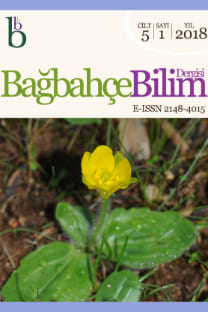Balaban Dağı (Balıkesir/Dursunbey) ve çevresinde yayılış gösteren geofit bitkiler ve ekolojik özellikleri
Bu çalışmada Balaban Dağı (Balıkesir/Dursunbey) ve çevresindeki geofit bitkiler tespit edilerek, taksonların ekolojik özellikleri ortaya konmuştur. Çalışma sonucunda, alanda 20 familyaya ait 43 cins ve 63 takson (7’ si endemik) tespit edilmiştir. Araştırma alanında en fazla taksona sahip familyalar; Asparagaceae (12), Orchidaceae (10) ve Iridaceae (9); en çok taksona sahip cinsler ise Crocus L. (4), Muscari L. (4) ve Ornithogalum L. (3)’ dur. Alanda tespit edilen taksonların % 35’ i tuberli, % 30’ u soğanlı, % 21’i rizomlu ve % 14’ ü kormludur. Ekolojik çalısmalarda ise, türlerin yetişme ortamlarından alınan toprak örneklerinin, fiziksel ve kimyasal özellikleri ortaya konmuştur.
Anahtar Kelimeler:
Balaban Dağı, geofit, Asparagaceae, yumru, toprak
Leaf Micromorphogy of Cultivated Lettuce (Lactuca sativa L.) and its Wild Relatives
Cultivated lettuce (Lactuca sativa L.) is an economically important weedy plant for human consumption at worldwide. The primary gene pool of L. sativa consists of wild L. serriola L., L. aculeata Boiss. & Kotschy, L. azerbaijanica Rech. f., L. georgica Grossh. and L. scarioloides Boiss. while L. saligna L. is in its secondary gene pool. L. sativa has been subjected to various studies due to its economic importance. This study aims to reveal leaf micromorphology of the taxa in the primary and secondary gene pool of L. sativa and determinate these relationships based on leaf micromophological characters through phenetic analysis. In order to achieve these aims, character states of leaves belonging to the taxa were determined through multiple sampling and these data were subjected to analysis. According to the micromorphological data, L. saligna is the closest species to L. sativa and undulate anticlinal wall of epidermis cells is shared common character state for both taxa. The most variation was observed in density of epicuticular wax and wax type among the studied micromorphological characters. On the other hand the states of anticlinal and periclinal walls of epidermis cells are stable within the taxa. Indumentum on abaxial leaf surface is also stable within the taxa except L. saligna. In the light of these findings, anticlinal-periclinal walls of epidermis cells and indumentum can be used as distinctive characters to determine the boundaries between taxa in systematic studies in Lactuca.
Keywords:
Asteraceae, epidermis wall shape, lettuce gene pool, wax,
___
- Akbaş, K. ve Varol, Ö. (2017). Bozburun yarımadası’nın geofitleri. Iğdır Üni. Fen Bilimleri Enst. Der., 7(2):73-81 Altundağ Çakır, E. (2017). Geophytes of Iğdır (East Anatolıa) and their economic potentialities as ornamental plant. Eurasian Journal of Forest Science (2017) 5(1): 48-56 Atay, S. (1996). Soğanlı bitkiler, türkiye’de ihracatı yapılan türlerin tanıtım ve üretim rehberi, İstanbul, 84 s. Avcu, C., Selvi, S. ve Satıl, F. (2016). Geophytes plants and ecological properties distributed in Katran Mount (Bayramiç /Çanakkale) and its environs. Iğdır Üni. Fen Bilimleri Enst. Der., 6(3): 9-16. Başköşe, İ., Paksoy, M.Y. ve Selvi, S. (2013). Geophytic Plants Around The Akkaya Dam Lake Niğde-Turkey, Acta Horticulturae (ISHS) 1002: 43-47. Baytop, T. (1999). Türkiye de Bitkiler ile Tedavi. İstanbul Üniversitesi Yayınları, İstanbul. Brummitt, R. K. ve C. E. Powell (Eds.). (1992). Authors of plant names. A list of authors of scientific names of plants, with recommended standard forms of their names, including abbreviations. Kew. 732 pp. Çelik, A., Çiçek, M., Semiz, G. ve Karıncalı, M. (2004). Taxonomical and ecological investigations on some geophytes growing around Denizli province (Turkey). Turk J Bot 28: 205-211. Çıngay, B., Ataşlar, E. ve Koyuncu, O. (2012). Geophytes of Yazılıkaya (Han-Eskişehir, Turkey). Bocconea 24: 227- 230. Davis, P.H. (1988). Flora of Turkey and The East Aegean Islands. Vol. 10, Edinburgh University Press, (supplement 1), Edinburgh, UK. 228s. Değerli, Y., Varol, Ö. (2018). Geophytes of Kızıldağ, Masa Mountain and Yılanlı Mountain (Muğla/Turkey). Biodicon, 11(3): 71-75. Demirelma, H. ve Ertuğrul, K. (2016). The geophytes of the region between Derebucak (Konya/Turkey)–Ibradı and Cevizli (Antalya/Turkey). Biodicon 9(3): 52-57. Eker, İ., Koyuncu, M. ve Akan, H. (2008). The geophytic flora of Şanlıurfa Province. Turk J Bot 32: 367–380. Ekim, T., Koyuncu, M., Vural, M., Duman, H., Aytaç, Z. ve Adıgüzel, N. (2000). Türkiye Bitkileri Kırmızı Kitabı. Türkiye Tabiatını Koruma Derneği ve Van Yüzüncü Yıl Üniv., Ankara. Güner, A., Özhatay, N., Ekim, T. ve Başer KHC (eds.) (2000). Flora of Turkey and the East Aegean Island. (Suppl. 2), Vol. 11, Edinburgh University Press. Edinburgh, UK. Güner, A., Aslan, S., Ekim, T., Vural, M. ve Babaç, M.T. (edlr.). (2012). Türkiye Bitkileri Listesi (Damarlı Bitkiler). Nezahat Gökyiğit Botanik Bahçesi ve Flora Araştırmaları Derneği Yayını, İstanbul. Haspolat, G., Şenel, Ü., Gökkür, S. ve Kesici, A. (2017). Türkiye süs bitkileri genetik kaynakları. ANADOLU, J. of AARI 26 (2): 51 – 64. Hopa, E., Tümen, G., Sevindik, E. ve Selvi, S. (2013). Kazdağları’nda yetişen (Balıkesir) endemik Muscari Mill. taksonları üzerinde karşılaştırmalı morfolojik ve ekolojik araştırmalar. Biyoloji Bilimleri Araştırma Dergisi (BIBAD), 6(1): 1-5. Malyer, H. (1983). Karacadağ'daki (Diyarbakır-Urfa arasındaki) Liliaceae ve Iridaceae familyalarına ait geofitler üzerinde korolojik ve ekolojik incelemeler. Doğa Bilim Derg Seri C 7 (3): 279-288. Mammadov, R. ve Sahranç, B. (2003). Muğla il merkezinde tespit edilen bazı geofitler. Ekoloji Çevre Derg 12 (48): 13-18. Kaçar, B. (1997). Toprak analizleri (Bitki ve toprağın analizleri III). Ank. Univ. Ziraat Fakültesi, Eğitim Araştırma ve Geliştirme Vakfı Yayınları, No: 3, Ankara. Satıl, F. ve Selvi, S. (2007). An anatomical and ecological study of some Crocus L. taxa (Iridaceae) from the west part of Turkey. Acta Botanica Croatica, 66(1): 25-33. Seyidoğlu, N. ve Yayım, D. (2009). Geophytes as medicinal and aromatical plants. Acta Hortic., 826, 421-426. Yüce Babacan, E. ve Eker, İ. (2017). Munzur Vadisi (Tunceli) ve yakın çevresinin geofit florası. Bağbahçe Bilim Dergisi, 4(1) 31-49.
- ISSN: 2148-4015
- Yayın Aralığı: Yılda 3 Sayı
- Başlangıç: 2014
- Yayıncı: Ali Nihat Gökyiğit Eğitim ve Sağlık Kültür Sanat ve Doğal Varlıkları Koruma Vakfı
Sayıdaki Diğer Makaleler
Türkiye Florası İçin Yeni Bir Bitki Takson Kaydı: Zantedeschia aethiopica (L.) Spreng. (Araceae)
József Andrasovszky’nin (1889- 1943) 1911 Yılı Anadolu Botanik Gezisi
ÖMER ÇEÇEN, Zeki AYTAÇ, Hüseyin Mısırdalı, Ayvaz ÜNAL
EL Bayda –Lamluda (El Cebel EL Akdar /Libya ) Florası
EL Bayda-Lamluda (El Cebel EL Akdar /Libya ) Florası
